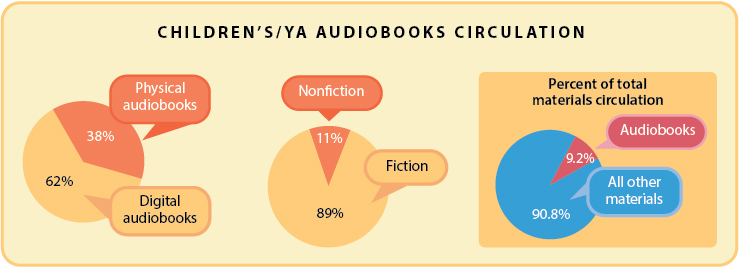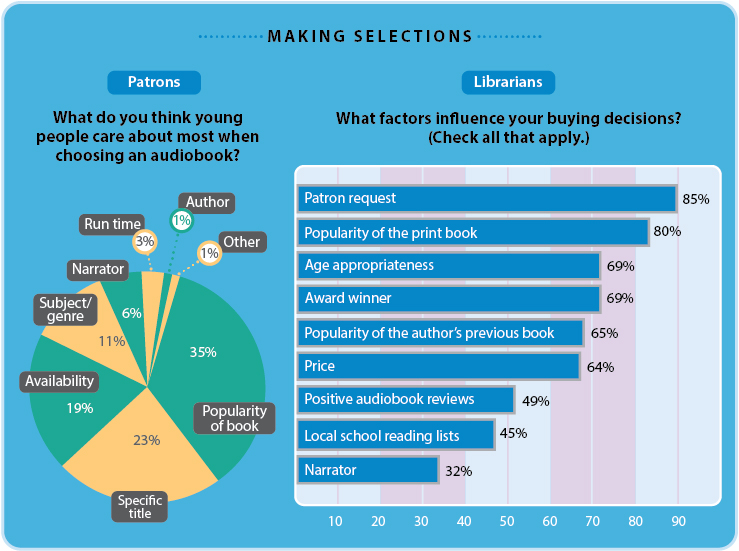From a Young Age, Children Tune in to Audiobooks | Survey
Children are eager listeners—of audiobooks, according to a new Library Journal / School Library Journal survey. Libraries are keeping up with the demand as formats evolve.

Children are eager listeners—of audiobooks, according to a new Library Journal / School Library Journal survey. Almost all public libraries now carry audiobooks for teens and children, the survey of nearly 500 public librarians found. Currently, 93 percent of public libraries offer children’s titles, and 83 percent carry YA titles. Young people greatly prefer fiction, and most don’t care who narrates the story. Meanwhile, librarians are concerned about AI replacing human narrators.
While demand for audio is robust, digital formats and devices including VOX Books from Library Ideas, preloaded Playaways, and Playaway Wonderbooks are replacing physical audio, such as CD formats. Digital listening is so popular, in fact, that 13 percent of libraries plan to stop buying physical audio titles for youth in the next few years.
Many children are growing up with audiobooks now, librarians said. “Kids in our community listen to audiobooks as they are learning to read and then continue to listen as they grow older, even if they are able to read the story,” according to Sammy Nieman, youth services librarian at Sun Prairie (WI) Public Library and a survey respondent. “We have a very large collection, and it is checked out the majority of the time because it is so popular.”
About 12 percent of those who borrow children’s and YA audiobooks do so exclusively, meaning they don’t check out other library materials.
What are young people listening to? Among children and young adults, 89 percent seek fiction audio, and 11 percent nonfiction. Correspondingly, libraries spend 90 percent of their audio budget on fiction and 10 percent on nonfiction.
Overall, audiobooks make up 9.2 percent of total youth circulation.
Regarding format, children and families prefer digital because fewer people own CD players, respondents said. “Most of our audiobooks on CDs don’t check out,” said Kate Blakely, head of children’s services at Bremen (IN) Public Library. “New cars come without CD players, and fewer people have CD players in their homes currently. This is the main motivation behind switching to Playaway’s all-in-one format.”
 The pandemic spurred digital borrowing. “[It] had a large effect on our physical-use CD books and pushed many patrons toward e-audio,” one respondent noted.
The pandemic spurred digital borrowing. “[It] had a large effect on our physical-use CD books and pushed many patrons toward e-audio,” one respondent noted.
“I focus on purchasing Playaways, whose circulation stats have significantly increased this year, as well as Wonderbooks and VOX Books,” print titles that come with audio recordings, said Toniann Buscarino, children’s librarian at Central Islip (NY) Public Library. Since “we have seen a significant decrease in patrons checking out audiobook CDs,” her library no longer purchases them.
One respondent pointed out a key reason to keep physical audiobooks, however. “Don’t assume everyone has internet access. Many of my patrons don’t have a computer, tablet, or smartphone; or don’t know how to use them—and don’t want to,” wrote Paula Gregory of New Florence (PA) Community Library. “Other patrons live in dead zones without reliable cell service or cable access. Also the dial-up internet available is garbage and unusable for downloading.”
While family listening is popular, parents like that individual kids can hear what they like on preloaded devices.
 “Our families love our Playaways and Wonderbooks,” said Caitlin Augusta, head of children’s services at Stratford (CT) Library. “They are used as reading tools for younger readers and an enjoyable activity by all children. Parents trust them, as they are not ‘screen time,’ and we heavily hand-sell them as well as our Hoopla offerings,” which include ebooks and audiobooks.
“Our families love our Playaways and Wonderbooks,” said Caitlin Augusta, head of children’s services at Stratford (CT) Library. “They are used as reading tools for younger readers and an enjoyable activity by all children. Parents trust them, as they are not ‘screen time,’ and we heavily hand-sell them as well as our Hoopla offerings,” which include ebooks and audiobooks.
“We have a lot of families who listen to audiobooks on road trips or together as a family,” noted Sarah Bean Thompson, youth services manager at Springfield-Greene County (MO) Library. “Playaway audiobooks, Wonderbooks/VOX, and digital audio [have] all grown in popularity as patrons want something they can listen to together or something that can appeal to multiple kids, like a Playaway for each child.”
Striving readers, reluctant readers, and emerging readers, especially, are audiobook fans, respondents said. They’re also popular with English-language learners. Sixty-six percent of libraries carried children’s and YA audio in languages other than English; however, those books average only about 2.5 percent of libraries’ total audio collections for young readers.
Format revolution
While audio overall is trending digital, physical audiobooks are more popular with youth than with adults, because they are easy for smaller hands to operate and can help young children get comfortable with reading. The majority of respondents confirmed that their libraries will keep buying physical children’s and YA audiobooks.
The “one copy/one user” licensing model is most popular in digital, accounting for 60 percent of those audio titles. Librarians said they most preferred that model, at 41 percent, with the simultaneous-use model almost as popular (40 percent).
More than half of librarians said that digital circulation rose over the last year. Meanwhile, 56 percent reported a decrease in physical audio and 23 percent an increase.
While audiobooks are clearly a draw for younger patrons, not much library programming is centered on them. Only eight percent of libraries offered audio-specific programming to children or teens in the past year. Those that did presented activities like listening book clubs or listening to a book while doing a craft.
Spending
Audio titles are a small but significant part of library spending, making up 8.2 percent of respondents’ total children’s and YA materials budget. Spending has risen in recent years for about a third of librarians—and fallen for around another third, especially in small libraries.
“Our overall audio spending has gone up due to a larger amount of money being spent on VOX and Wonderbooks,” said Macy Davis, children’s librarian at the Public Library of Brookline, MA. Libraries spend 41 percent on physical audio format versus 59 percent for digital.
What influences buying? Kelly Povero tries to only buy kids’ audio titles if she has the same book on the shelves in order to promote circulation. “Most people taking out children’s audio are families, particularly homeschooling in this area, so they are more likely to borrow something that has a book version as well,” said Povero, of Watkins Glen (NY) Public Library. “We have eliminated YA audio due to a lack of circulation.”
A Wisconsin children’s services librarian said the library is “adding physical picture books with built-in players” while reducing or eliminating children and teen audiobooks on CD or those with a book-CD kit.
An adult services librarian in California observed that physical audio presents quality control issues. “So often there are skips and/or freezes—it’s very aggravating. Furthermore, my purchasing level dropped significantly as prices began to skyrocket—often to the point of absurdity. I don’t listen to digital audiobooks but have heard there are problems in that arena as well.”
What drives choices?
Librarians use multiple research sources to vet audio titles before purchasing, including professional review publications, recommendations from colleagues, and newsletters or websites from publishers and vendors.
Patron request is the most important factor influencing children’s/YA audiobook selections at 85 percent, then the popularity of the print book at 80 percent. Other factors in selection are age appropriateness and whether the title has won awards.
While an audiobook’s narrator can make a huge difference to adults—many choose titles by the same narrator again and again—that’s less important to younger readers, who usually borrow based on the popularity of the title and immediate availability. While 66 percent of kids and teens consider the narrator when deciding what to check out, librarians estimated, only six percent said the narrator was the top factor.
“Kids looking at Playaways are usually not looking for a specific title, but just browse what’s available at the moment,” observed Whitney Jones, youth services librarian at Northville (MI) District Library.
“I think concerns that affect children’s/YA audiobook selection vs. audiobook selection for adults are very different,” said Davis of the Public Library of Brookline. “For example, families with children may choose books by length instead of genre, whereas adults may be more invested in a particular genre.”
Even if kids don’t initially think about voice, “audiobook listeners seem more open to trying a variety of genres [if] narrated by their favorite narrator,” added Thompson of Springfield-Greene County Library. “Narrators can make or break a listening experience. If patrons don’t like the narrator, they won’t listen to the book.”
An Indiana youth services manager views it this way: “A bad narrator can kill a story in its tracks. I’ve seen it over and over with a computer [voice] or a monotone voice, and the whole family will give up on it.”
While nearly one-third of librarians said the narrator is a factor when they select an audio title for purchase, that changes if the narrator is non-human or generated by artificial intelligence. Thirty percent would not choose a title with such a narrator, and 41 percent would only buy that title if there were no other narrator option.
“AI is an abomination,” one librarian wrote. “I’ve listened to several, and they don’t sound like real humans. They don’t have the warmth and nuance. I will never purchase them.”
Susan Barnum, branch manager of Sergio Troncoso Library in El Paso, TX, expressed a larger concern: “We are letting AI take over all our creative works. When that happens, what will become of the arts?”
While the impact of AI has yet to play out, audio format migration at libraries continues. “VOX Books and Wonderbooks have become very popular,” affirmed Jamie Stroble, collection development librarian at Forsyth County (NC) Public Library. “I will be adjusting my spending accordingly.”
|
METHODOLOGY: The survey questions were developed with the Audio Publishers Association. The survey invitation was emailed to a random sample of public library materials selectors and adult/youth services librarians on August 28, 2023. The survey closed September 10 with 490 U.S. public library responses. The sample included only library staff involved in recommending/purchasing audiobooks for their library. Respondents were ranched to either adult or children’s/YA questions based on their selection responsibilities (286 adult selectors and 194 children’s/YA selectors). The data was collected and analyzed in-house by LJ/SLJand remains unweighted. |
Marlaina Cockcroft is a writer and editor.
RELATED
The job outlook in 2030: Librarians will be in demand
The job outlook in 2030: Librarians will be in demand
ALREADY A SUBSCRIBER? LOG IN
We are currently offering this content for free. Sign up now to activate your personal profile, where you can save articles for future viewing








Add Comment :-
Be the first reader to comment.
Comment Policy:
Comment should not be empty !!!